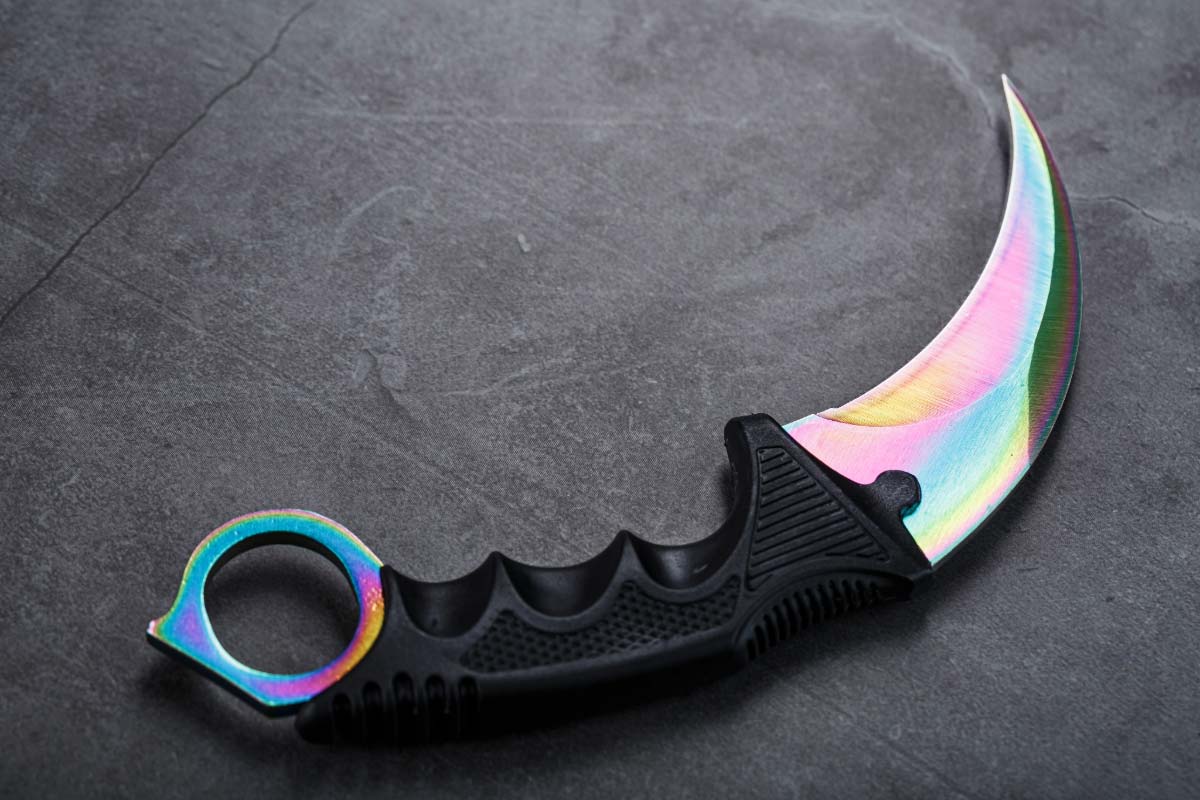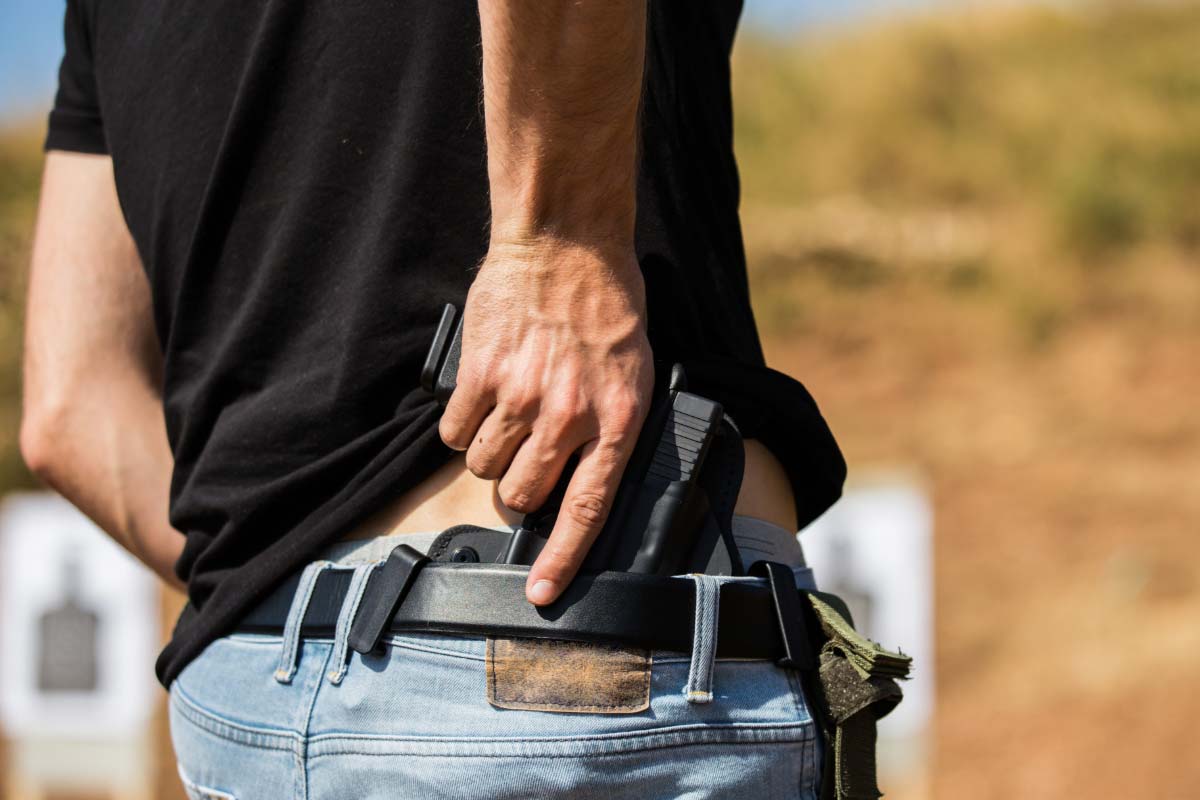In an age where personal safety is a growing concern, many individuals consider carrying a knife for self-defense. The idea of having a tool that could potentially ward off an attacker is appealing, but is it truly an effective form of protection, or does it introduce more legal and ethical risks than it mitigates?
Learn the complexities of using a knife as a means of self-defense, examining the practical realities, legal boundaries, and safer alternatives to ensure your personal security.
In this article, we’ll cut through the myths and uncover the sharp truths about knife defense.
This article covers:
Understanding Knife Laws
Before an individual decides to carry a knife for self-defense, they must be aware of the varying knife laws that govern their jurisdiction. These laws dictate if it’s legal to carry a knife, and outline what is permissible in terms of knife type and blade length.
Legal Considerations
When considering carrying a knife, one must ensure they are not starting off a self-defense scenario by breaking the law. Local laws determine the legalities surrounding the carry of a knife. One should begin by researching the specific legislation pertaining to knives in their area to avoid legal complications.
Carry Laws
Each state or locality has its own carry laws that define whether it’s legal to have a knife in public. Often, these relate to the intent behind carrying the knife. Simple possession might be legal, while displaying or using it can have different implications. For instance, a short-bladed pocketknife might be legal in many areas, but there are clear distinctions about where and how a knife can be carried.
Regulations on Knife Length and Type
Laws typically specify the permissible knife length and type. For example, folding knives with blades under a certain length, such as 2 to 3 inches, might be universally acceptable, while longer blades may be restricted. Additionally, certain types of knives, like switchblades or butterfly knives, are often subject to stricter regulations or bans.
Pros and Cons of Knives for Self-Defense
When considering a knife for self-defense, it’s important to recognize that a knife may not incapacitate an attacker immediately.
Due to adrenaline and the body’s resilience, an assailant might not feel the full impact of a knife wound right away, potentially allowing them to continue their aggression.
The effectiveness of a knife largely depends on the location and severity of the wounds, with non-vital injuries unlikely to yield swift incapacitation.
Additionally, the use of a knife carries the risk of causing fatal injuries, which can have profound legal and moral consequences.
Given this, and the unpredictability of an attacker’s response to being wounded, individuals should thoughtfully assess the risks associated with using a knife in self-defense.
Non-lethal options may offer a more controlled response, reducing the likelihood of lethal outcomes and the associated legal and ethical complexities.
Here are some common pros and cons to consider for using a knife in self-defense:
Pros:
- Utility: Knives are versatile tools for everyday tasks, not just for defense.
- Concealability: They can be easily concealed, making them a discreet defense option.
- Intimidation: A visible knife can deter potential attackers before a confrontation escalates.
- No Reliance on Ammunition: Unlike firearms, knives don’t require reloading or ammunition.
- Easily acquired: Affordable and accessible, with widespread availability and easy replacement.
Cons:
- Legal Issues: Carrying knives is heavily regulated, and in some areas, it’s illegal to carry them for the purpose of self-defense.
- Training Required: Effective use demands significant training; inexperienced individuals might be disarmed and have their knife used against them.
- Close Range: Knives are close-quarters weapons, forcing the defender into proximity with the attacker.
- Lethality and Legal Repercussions: Using a knife can cause serious harm or be lethal, resulting in severe legal consequences even if used in self-defense.
- Escalation: Introducing a knife into a confrontation can escalate the situation and increase the likelihood of serious injury or death.
- Limited control: Holding a knife reduces the ability to control an opponent or defend against weapons due to one-handed engagement.
Knife Selection for Self-Defense
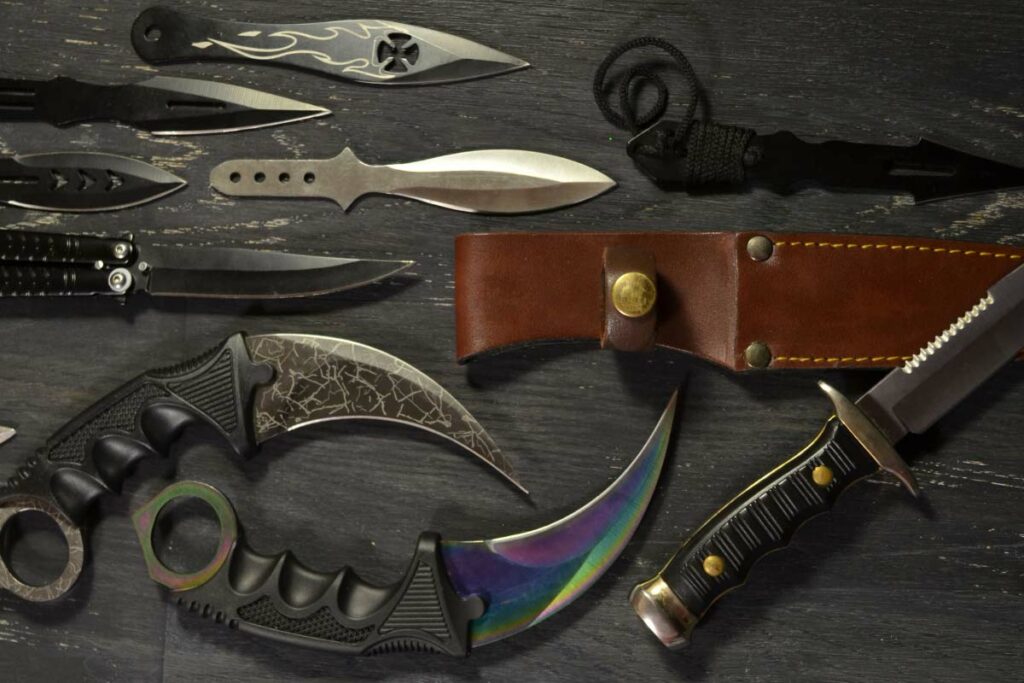
Selecting the right knife for self-defense involves considering several factors, such as the type of knife and the quality of its blade. These considerations are critical for ensuring the knife can be relied upon if needed for protection.
Fixed Blade vs. Folding Knife
A fixed-blade knife typically offers more strength and reliability due to the absence of moving parts. They are easier to maintain and clean since they do not have the crevices and mechanisms of a folding knife.
On the other hand, a folding knife is more discreet and portable, allowing for convenient everyday carry.
When it comes to self-defense situations, the time it takes to deploy the knife is crucial; folding knives can be slower to engage compared to their fixed-blade counterparts which are ready for immediate use.
Blade Shape and Size
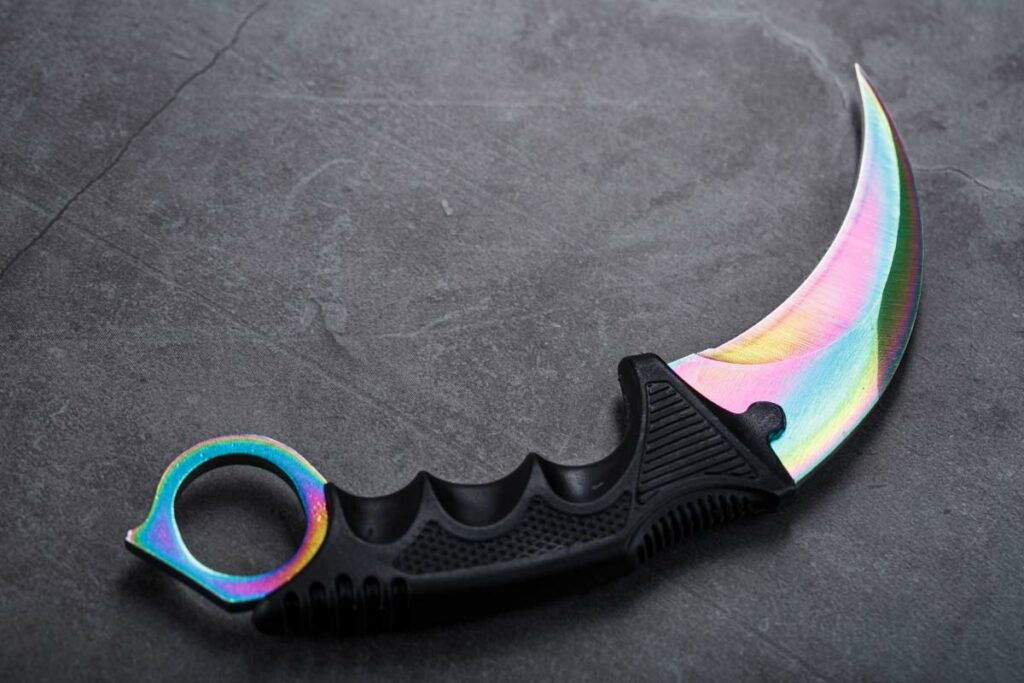
The blade shape directly influences the knife’s effectiveness in self-defense scenarios.
A karambit knife, for example, with its curved blade, is designed for slicing and hooking motions. This contrasts with straight-edged blades that are versatile for both self-defense and general-purpose use.
The size of the blade is also important; typically, a blade length of 3-5 inches is suitable for self-defense as it offers a balance between control and legal carry limitations.
High-quality knives should hold an edge well and resist corrosion, so materials and construction are key factors to consider.
Carrying Methods and Accessibility
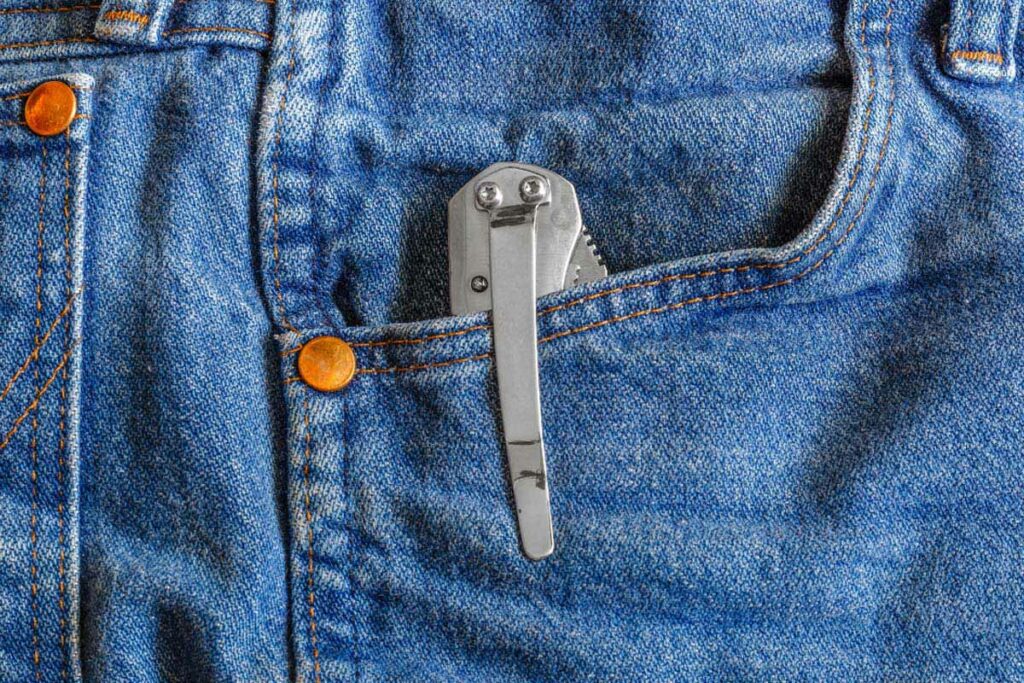
When choosing to carry a knife for self-defense, the method you choose is crucial for ensuring the weapon is concealed yet accessible.
Each carry option has its own form-fitting function and varies greatly in terms of accessibility and ease of draw.
Traditional Carry Locations
Traditional carry locations for knives include inside-the-waistband (IWB) on the same side as the dominant hand or outside-the-waistband (OWB) on the strong side.
Another common and accessible location is the support-side pocket, which offers quick access.
Boot knives are a discreet option, though they require more effort to access.
For immediate reachability, neck knives provide an alternative that is easily hidden and quickly deployable.
Concealed vs. Open Carry
When most people think of concealed carry, they are typically referring to concealed carry of a firearm. However, this concept applies to any personal protection weapon such as a blade or knife.
The decision between concealed and open carry is influenced by legality and personal preference.
Concealed carry is typically more advisable for self-defense, as it avoids drawing attention yet keeps the knife readily accessible.
Form-fitting attire can effectively conceal the knife while maintaining its accessibility. IWB appendix carry and pocket-carry are preferred methods for concealment that balance discretion with ease of access.
Specialized Carry for Readiness
Certain specialized carry options can enhance readiness. A cross-body carry allows for accessibility from various positions, and its positioning across the body can facilitate a quick and natural draw. Additionally, keeping a knife in an easily reachable support-side pocket may facilitate access in unexpected situations. Each specialized method should be practiced to ensure the carrier can rapidly deploy the knife in a high-stress encounter.
Self-Defense Techniques and Training
Effective self-defense with a knife requires specific skills and training. Individuals should focus on mastering basic handling, seeking professional guidance, and understanding varied engagement scenarios to enhance their defensive capabilities. There are specific martial arts disciplines that focus on weapons, and more specifically, fighting with knives.
Basic Knife Handling Skills
Before one can effectively use a knife for self-defense, mastering basic handling skills is crucial.
This includes learning the proper fighting stance to maintain balance and readiness.
One should practice the most efficient ways to grip a knife to ensure control and precision during a confrontation.
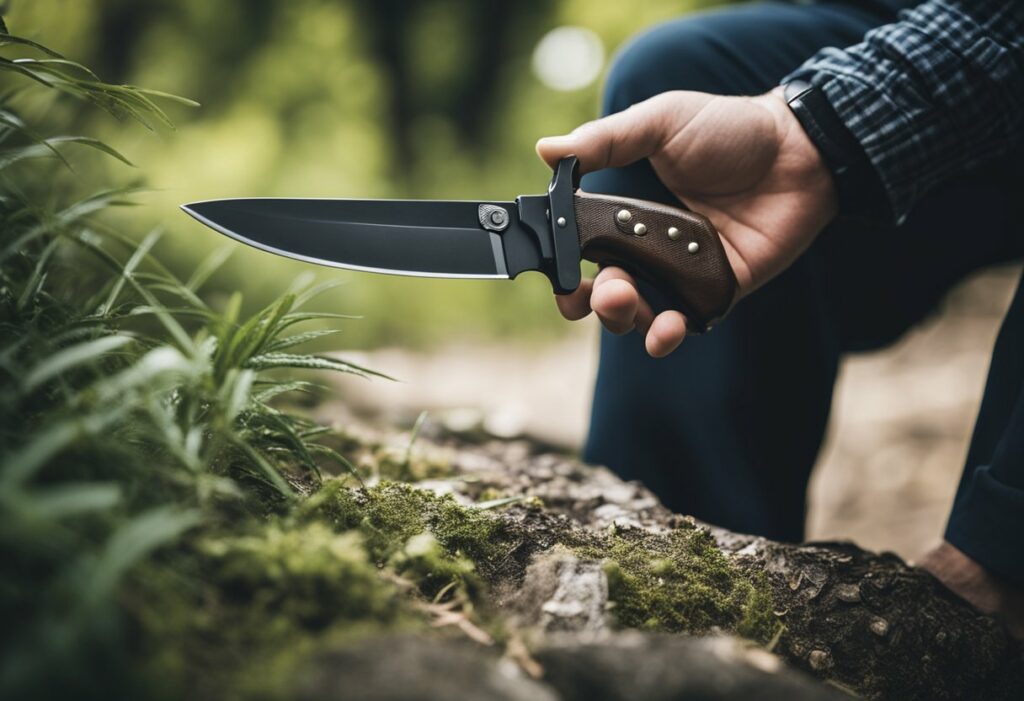
It’s also important to become familiar with the tactical options for wielding a knife, including defensive postures and offensive maneuvers.
It would also be beneficial to learn knife disarms and how to avoid a defender that approached you with a knife. Higher levels of training in Krav Maga teaches weapons defenses including disarming an attacker thats holding a knife.
Here are some examples of basic knife skills that may be covered:
Weapon Retention: This is a critical skill that ensures you maintain control over your knife during a confrontation. Techniques taught include how to hold the knife securely to prevent it from being knocked out of your hand or taken by an opponent. Practitioners learn to use their body positioning and grip strength to protect their weapon.
Proper Grip: The way you grip a knife can vary depending on the intended use and the specific martial art. For example, a common grip taught in many systems is the forward or reverse grip.
The forward grip, with the blade extending from the top of the fist, is often used for precise cutting and thrusting.
The reverse grip, with the blade extending from the bottom of the fist, is used for power slashes and hooks.
Each grip has its own applications and is chosen based on tactical considerations.
Stabbing vs. Slashing: Understanding the difference between stabbing (thrusting) and slashing (cutting) attacks is fundamental to knife training. Stabbing attacks are typically aimed at vital targets and are designed to penetrate deeply, while slashing attacks are usually quicker and can be used to create distance or target superficial veins and arteries.
Angles of Attack: Knife practitioners learn the angles of attack, which refer to the direction from which an offensive technique is delivered. These angles help practitioners understand how to deliver strikes effectively and how to defend against them. For example, Filipino Martial Arts often categorize attacks into specific numbered angles that correspond to different types of strikes.
Professional Training and Martial Arts
Engaging in professional training is one of the best ways to ensure that when one uses a knife for self-defense, they do so effectively and responsibly.
Trained instructors can provide valuable insights into the martial arts techniques that are most applicable to knife defense.
Participants learn not just how to handle a knife, but also how to respond to attacks with the appropriate level of force.
Professional training often includes live drills that simulate real-world scenarios, enhancing the individual’s tactical decision-making and reflexes.
Several martial arts disciplines include extensive training with knives, focusing on both offensive and defensive techniques.
Here are a few that are well-known for their knife training components:
Filipino Martial Arts (FMA): Often referred to by names like Kali, Eskrima, or Arnis, these martial arts from the Philippines are renowned for their weapon-based training, which includes extensive work with knives and other bladed weapons.
Silat: This martial art originates from Southeast Asia and encompasses a variety of styles, many of which include training with edged weapons, such as knives.
Krav Maga: Developed for the Israeli military, Krav Maga is a practical self-defense system that incorporates knife defense and knife fighting techniques as part of its curriculum, focusing on real-world situations.
Systema: A Russian martial art that includes comprehensive training in unarmed combat, as well as knife fighting and defense techniques.
Hapkido: A Korean martial art that, while primarily focused on joint locks and throws, also includes training with a variety of weapons, including knives.
Aikido: While Aikido is generally known for its non-aggressive techniques and philosophy, some schools and styles include knife techniques as part of their training, focusing on disarming and redirecting the energy of an attacker.
While these martial arts include knife training, the focus and context can vary greatly between them.
Some emphasize self-defense, others focus on the historical and traditional aspects of weapon use, and some approach knife training from a more combative sport perspective.
Understanding Engagement Scenarios
Comprehension of various engagement scenarios is imperative for self-defense situations. One should learn to quickly assess their environment and identify potential threats and exit points. Training can also help individuals understand when it’s best to brandish a knife for deterrence versus when to engage physically. Through repeated scenario training, individuals develop the situational awareness necessary to navigate tense situations with poise and confidence.
Potential Consequences and Alternatives
Before deciding to carry a knife for self-defense, one must understand the potential legal consequences and consider various non-lethal alternatives. Self-defense laws are complex and using lethal force can result in severe repercussions.
Understanding the Implications of Using Lethal Force
Using a knife can be classified as lethal force, and its deployment in self-defense can lead to significant legal scrutiny.
If a confrontation leads to death or serious injury, the individual using the knife must prove it was justified.
This can be a challenging process, where every action they took is dissected in court. Thus, understanding the repercussions of lethal force is vital before deciding to carry a knife for self-defense.
Non-Lethal Alternatives
There are safer alternatives to knives that minimize the risk of legal and ethical complications.
Pepper spray, for example, serves as an effective deterrent and can incapacitate an attacker without causing permanent harm.
Likewise, individual strategy can include taking self-defense classes to prepare non-lethal response tactics. These options help ensure personal safety while reducing the potential for severe consequences.
The Importance of Legal Advice Post-Incident
After an incident involving self-defense, seeking legal counsel is essential. An attorney can navigate the complexities of self-defense law and work to minimize legal implications. They offer advice on appropriate strategy and steps to take immediately following an incident. Securing legal representation early can be crucial in managing the potential consequences following the use of a knife in self-defense.
What are you thoughts on carrying a knife for defense? Do you think it’s an affective weapon for personal protection or a liability? Leave a comment below.





